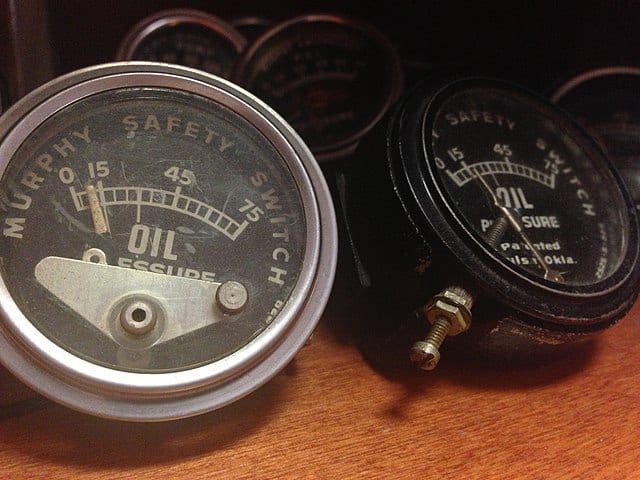An oil pressure sensor is a device in an RV that is used to measure the oil pressure on the engine. This sensor controls the oil pressure gauge in an RV which lights up as a warning when there is a problem with the oil pressure.
The oil pressure sensor will signal problems like low oil pressure, an oil leak, or that the engine is burning oil. The oil pressure sensor may also light up as a warning that the sending unit is faulty. It is important to test the oil pressure sensor to find the fault.
An oil pressure sensor is a device in an RV that is used to measure the oil pressure on the engine. Oil temperature and pressure gauge from a light aircraft by RobbieMcConnel / Wiki Commons / CC BY-SA 3.0
How To Test an Oil Pressure Sensor
An oil pressure sensor is tested using an electrical testing tool known as a multimeter. The way an oil pressure sensor is tested will depend on the type of oil pressure sensor or switch it is. Oil pressure sensors or switches can come with one, two, or three pins and each will be tested slightly differently as we will see below.
Step 1: Lock the Engine Out
Make sure the engine is locked out by disconnecting the battery.
Step 2: Test the Resistance with the Engine Off
Set your multimeter to measure resistance or to test if there is an open or closed circuit. Test the resistance by connecting one lead of the multimeter to the terminal for the warning light on the oil pressure sensor and touch the second lead to the sensor housing.
A correctly functioning oil pressure sensor will show a reading of 0 ohms on the meter. Now connect the lead to the terminal for the oil pressure sending unit and the metal housing. The reading on the meter should read as an open circuit.
Step 2: Test the Resistance with the Engine On
Now test the oil pressure sensor with the engine running by connecting the switches as stated below. If the oil pressure sensor is working and there is oil pressure present in the engine, the switch terminal should read infinity on the multimeter, which indicates an open circuit.
Testing Different Types of Oil Pressure Switches
1. One-Pin Oil Pressure Switch
On a single pin oil pressure switch, the multimeter must be connected between the pin and the body of the oil pressure sensor. A single-pin oil pressure switch has one connection on the pin and the other through the body of the switch to the engine block.
The connection between the body of the switch and the engine block acts as an earth connection. The switch will be closed while the engine is turned off and open when the engine is running.
2. Two-Pin Oil Pressure Switch
A two-pin oil pressure switch has two types of connections:
- i) A two-pin oil pressure switch with one pin as a ground
- ii) A two-pin oil pressure switch with one pin normally open and one pin normally closed
Two-Pin Oil Pressure Switch with One Pin as Ground
This type of switch works between the two pins and doesn’t use its body as the ground connection as with the one-pin switch. Testing a two-pin oil pressure switch with one pin as a ground is the same as testing a one-pin switch – simply connect the multimeter between the two pins. The switch will be closed while the engine is turned off and open when the engine is running.
Two-Pin Oil Pressure Switch with One Pin Normally Open and One Pin Normally Closed
In this type of oil pressure switch, one of the pins will be closed when the oil pressure is low, and the other one will be open. When the oil pressure in the engine rises, each pin will change its state.
3. Three-Pin Oil Pressure Switch
A three-pin oil pressure switch has two pins that switch states like the two-pin oil pressure switch with one pin normally open and one pin normally closed, and a common connection like the body that is ground.
Testing a three-pin oil pressure switch is slightly more complicated than the other two types of switches. To test the switch, you need to know which pin is normally open, which pin is normally closed, and which pin is ground.
Once this is confirmed, connect the multimeter between the normally closed pin and the common pin. The circuit will be closed while the engine is turned off and open when the engine is running.
The lights on the oil pressure gauge are the best indicator that something is wrong with your oil pressure sensor or switch. A classic oil pressure switch gauge made by FW Murphy in the 1950s by User:codybrom / Wiki Commons / CC BY-SA 3.0
Frequently Asked Questions
How do you know if your oil pressure sensor is faulty?
The lights on the oil pressure gauge are the best indicator that something is wrong with your oil pressure sensor or switch. If the oil levels in the engine are normal and the engine is running smoothly but the low oil pressure warning light starts blinking, it is more than likely a faulty oil pressure sensor.
Can I drive with a faulty oil pressure sensor?
It is not a good idea to continue driving with a faulty oil pressure sensor as it could cause major engine damage. Stop driving until you have tested the oil pressure sensor to find what the problem may be.
How do you reset the oil pressure sensor?
Resetting the oil pressure sensor is fairly simple. Insert the key into the ignition of the RV and turn it to the “on” position without starting the engine. The oil pressure sensor light should come on. Press the gas pedal three times slowly. This will reset the oil pressure sensor system. Turn the ignition off and on again to see whether it has reset.
Conclusion
As with most parts of any vehicle, it is important to keep them in good working condition to ensure the vehicle is safe to drive. The oil pressure switch is one such part that needs to be maintained to monitor the oil pressure in the engine. Low oil pressure can cause friction between different parts of the engine, which can lead to a decline in engine performance and engine damage.


Jill Miller is the founder of Your RV Lifestyle. Trading corporate America for the open road, Jill, along with her partner Jose, began their RV journey, making an unconventional start by wintering in New Jersey. A natural adventurer, she was motivated by a desire to explore the USA and beyond, embracing the varied landscapes, communities, and cultures across the country.
For Jill, the allure of RV living was not about material accumulation, but rather the pursuit of an adventurous, fulfilling lifestyle. A lover of golf, bicycling, hiking, and line dancing, she has carried her passions across the country, engaging with them in diverse settings. Jill’s commitment to the RV lifestyle came after years of careful research, numerous consultations with RV owners, and personal trials, including living in a rental RV.


